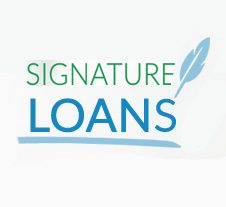Table of Contents
Introduction: How Signature Loans Can Help You Crush Debt
Debt can be a heavy burden, overshadowing your financial goals and keeping you up at night.
If you’re struggling with multiple high-interest debts, finding a way out might seem daunting. But there’s a tool that could help you simplify and accelerate your journey to financial freedom: signature loans. These unsecured personal loans offer a viable solution for consolidating your debts, reducing interest rates, and making your repayment plan more manageable.
Let’s explore how signature loans can empower you to crush your debt and regain control over your finances.

Understanding Signature Loans
What Are Signature Loans?
A signature loan, often referred to as an unsecured personal loan, is a type of loan that doesn’t require collateral.
Unlike secured loans—where you need to put up assets like your home or car as a guarantee—signature loans are approved based solely on your creditworthiness, income, and promise to repay.
This “signature” commitment makes them accessible to many borrowers, particularly those looking for a straightforward way to manage their debt.
How Do Signature Loans Work?
When you apply for a signature loan, the lender evaluates your credit score, income, and overall financial situation to determine your eligibility. If approved, you receive a lump sum, which you can use for various purposes—such as debt consolidation, home improvements, or unexpected expenses.
The loan is then repaid through fixed monthly installments over a set period, typically ranging from two to five years.
Benefits of Signature Loans
Signature loans offer several advantages, particularly when used for debt consolidation:
- No Collateral Required: You don’t have to risk losing personal assets if you’re unable to repay the loan.
- Fixed Interest Rates: Many signature loans come with fixed interest rates, providing stability and predictability in your monthly payments.
- Versatility: These loans can be used for nearly any purpose, including consolidating and repaying high-interest debts.
The Role of Signature Loans in Debt Management
How Signature Loans Can Help You Crush Debt
If you’re juggling multiple debts—such as credit cards, medical bills, or small personal loans—each with its own interest rate and payment schedule, managing them can feel overwhelming.
A signature loan can help by consolidating all of your debts into a single, more manageable payment. By doing so, you can often secure a lower interest rate than what you’re currently paying, reducing the total amount of interest over the life of the loan. This not only simplifies your debt management but can also accelerate your journey to being debt-free.
Signature Loans for Debt Consolidation
Debt consolidation is a popular use for signature loans. Here’s how it works:
- Combine Multiple Debts: You take out a signature loan large enough to pay off all your existing debts.
- Single Monthly Payment: Instead of keeping track of several payments, you now have just one fixed monthly payment to focus on.
- Lower Interest Rate: If you qualify for a lower interest rate, you’ll save money in the long run, as more of your payment will go toward the principal rather than interest.
When to Consider a Signature Loan for Debt Repayment
A signature loan might be the right choice if:
- Your Credit Score Is Strong: A good credit score can help you secure a lower interest rate.
- You Have Multiple High-Interest Debts: Consolidating can simplify your payments and reduce interest costs.
- You Need Predictable Payments: Fixed monthly payments can help you budget more effectively.
Key Benefits of Using Signature Loans to Manage Debt
Lower Interest Rates Compared to Credit Cards
One of the most compelling reasons to use a signature loan for debt consolidation is the potential to secure a lower interest rate than what you’re paying on your credit cards, ultimately helping you crush debt faster.
Credit cards typically have variable interest rates that can soar to 20% or higher, especially if you’ve missed payments or are only making minimum payments.
In contrast, signature loans often offer fixed rates, which are usually lower, depending on your creditworthiness. This difference can significantly reduce the overall cost of your debt, making it easier to pay off and achieve financial freedom.
Simplified Debt Management
Managing multiple debts can be challenging. Each debt may have a different due date, interest rate, and minimum payment, which can lead to missed payments and higher interest charges.
A signature loan streamlines this by consolidating your debts into one loan with a single monthly payment.
This simplification can help you stay organized, reduce the risk of missed payments, and make it easier to track your progress toward becoming debt-free.
Fixed Monthly Payments and Predictability
One of the benefits of a signature loan is the predictability it offers, which can be a crucial factor when you’re strategizing to crush your debt.
Unlike credit card payments, which can fluctuate based on your balance and interest rates, signature loans have fixed monthly payments. This consistency allows you to budget more effectively, knowing exactly how much you need to allocate for debt repayment each month, making it easier to crush your debt and stay on track.
With a clear timeline for when the loan will be paid off, you can see the light at the end of the tunnel and work steadily toward it.

How to Use a Signature Loan for Debt Repayment
Assessing Your Debt Situation
Before applying for a signature loan, it’s essential to take stock of your current debt in order to effectively crush debt.
Make a list of all your outstanding debts, including the total amounts owed, interest rates, and minimum monthly payments. This will give you a clear picture of your financial situation and help you determine how much you need to borrow to consolidate your debts and pave the way to financial freedom.
Choosing the Right Lender
Not all lenders are created equal, and the terms of a signature loan can vary widely depending on where you apply.
Consider shopping around and comparing offers from different lenders, including banks, credit unions, and online lenders.
Pay attention to interest rates, fees, and repayment terms to ensure you’re getting the best deal possible. It’s also a good idea to read reviews and check the lender’s reputation to ensure they are trustworthy and reliable.
Calculating How Much You Need
When deciding how much to borrow, it’s important to strike a balance.
You want to borrow enough to pay off all your existing debts, but not so much that you end up taking on more debt than you can handle. Use your assessment of your debt situation to calculate the amount you’ll need.
Remember to factor in any fees associated with the loan, as these can add to the total cost.
Qualifying for a Signature Loan
Credit Score Requirements
Your credit score is a key factor in determining whether you qualify for a signature loan and what interest rate you’ll be offered.
Generally, lenders look for a credit score of at least 580 to 660, though some may have higher or lower thresholds. If your score is on the lower end, you may still qualify, but you might face higher interest rates.
Improving your credit score before applying can increase your chances of getting a better rate.
Income and Employment Verification
In addition to your credit score, lenders will typically require proof of income and employment to ensure you have the means to repay the loan. This might include recent pay stubs, tax returns, or bank statements.
A stable job history and sufficient income relative to your debt levels can improve your chances of approval.
Preparing Necessary Documentation
When applying for a signature loan, having all your documentation in order can speed up the process. Common documents you’ll need include:
- Proof of Identity: A government-issued ID, such as a driver’s license or passport.
- Proof of Income: Recent pay stubs, W-2 forms, or tax returns.
- Proof of Residence: Utility bills or lease agreements showing your current address.
- Credit History: Some lenders may request permission to pull your credit report.
Risks and Considerations
Potential Drawbacks of Signature Loans
While signature loans can be a powerful tool for managing debt, they aren’t without risks.
One potential drawback is that they often come with higher interest rates compared to secured loans because they don’t require collateral.
Additionally, if you’re not careful, you could end up using the loan for purposes other than debt repayment, which could derail your plans to crush debt and lead to even more financial burden.
Understanding Interest Rates and Fees
It’s crucial to understand the full cost of a signature loan before committing.
This includes the interest rate, which determines how much you’ll pay over the life of the loan, and any fees, such as origination fees, late payment fees, or prepayment penalties.
Some lenders may offer low rates but have high fees, so it’s important to look at the overall cost, not just the interest rate.
Avoiding the Debt Cycle Trap
One of the risks of using a signature loan to consolidate debt is the temptation to accumulate new debt once your old debts are paid off. This can undermine your efforts to crush your debt and lead you back into a cycle of financial burden.
To avoid falling into this trap, it’s important to create a budget and stick to it. Focus on paying off your signature loan as quickly as possible and avoid taking on new debt until you’re in a more stable financial position.
Alternatives to Signature Loans for Debt Repayment
Balance Transfer Credit Cards
If you have good credit, a balance transfer credit card might be a viable alternative to a signature loan.
These cards often come with an introductory 0% interest rate on transferred balances for a set period, allowing you to pay off your debt without incurring additional interest.
However, if you don’t pay off the balance before the introductory period ends, you could be stuck with a high-interest rate.
Debt Management Programs
For those struggling with overwhelming debt, a debt management program (DMP) might be a better option.
These programs, typically offered by nonprofit credit counseling agencies, negotiate with your creditors to lower interest rates and create a manageable repayment plan.
You’ll make a single monthly payment to the agency, which then distributes the funds to your creditors.
Personal Savings and Rainy Day Funds
In some cases, using personal savings or a rainy day fund to crush debt might be the best choice. While this might deplete your savings, it could save you money on interest and help you get out of debt more quickly.
If you choose this route, make sure you have a plan to rebuild your savings afterward.

How to Apply for a Signature Loan
Step-by-Step Application Process
Applying for a signature loan typically involves the following steps:
- Research Lenders: Compare interest rates, fees, and terms from various lenders to find the best option.
- Pre-Qualification: Some lenders offer pre-qualification, which allows you to see what rates you might qualify for without a hard credit check.
- Complete the Application: Provide the necessary documentation and information, including your income, employment, and credit history.
- Approval: If approved, review the loan terms carefully before accepting. Make sure you understand the interest rate, repayment schedule, and any fees.
- Receive Funds: Once you accept the loan, the funds are typically deposited into your bank account within a few days.
Choosing Between Online Lenders and Traditional Banks
When it comes to choosing a lender, you have several options.
Traditional banks and credit unions often offer signature loans with competitive rates, especially for existing customers.
However, if you’re looking for a quick and convenient way to crush debt, online lenders can be a good alternative, especially if you’re looking for a quick and convenient application process.
Online lenders may also be more flexible with credit requirements, making them a viable option if your credit score is less than perfect.
What to Expect During the Approval Process
The approval process for a signature loan can vary depending on the lender and your financial situation. Generally, it involves a credit check, income verification, and a review of your debt-to-income ratio.
Some lenders may approve your loan within minutes, while others might take a few days to review your application.
If you’re applying through a traditional bank, you might need to visit a branch in person, while online lenders typically handle everything electronically.
Real-Life Success Stories
How Others Have Crushed Debt with Signature Loans
Many people have successfully used signature loans to take control of their debt and improve their financial situations.
For example, consider the story of Jane, who had accumulated $5,000 in credit card debt across multiple accounts. Struggling to keep up with the high-interest payments, she took out a signature loan with a lower interest rate, consolidating her debts into one manageable payment.
Within three years, she had paid off the loan, saving hundreds of dollars in interest and significantly improving her credit score.
Lessons Learned from Signature Loan Borrowers
One common theme among successful borrowers is the importance of discipline.
It’s crucial to use the loan specifically for debt repayment and resist the temptation to take on new debt, staying focused on the goal to crush debt.
Additionally, borrowers who have seen the most success often take the time to research and compare lenders, ensuring they get the best possible terms for their signature loans.
Common Mistakes to Avoid
When using a signature loan to manage debt, it’s important to avoid common pitfalls, such as:
- Borrowing More Than You Need: Only borrow what you need to pay off your existing debts. Taking on too much can lead to more financial strain.
- Ignoring Fees: Be aware of any fees associated with the loan, such as origination fees or prepayment penalties.
- Failing to Create a Budget: Without a budget, you might find yourself back in debt even after consolidating.

Conclusion
When used wisely, signature loans can be a powerful tool for consolidating high-interest debts and creating a clear path toward becoming debt-free—in essence, helping you crush debt and regain control over your finances.
By streamlining multiple payments into one manageable loan, you can simplify your financial obligations and potentially reduce your interest costs. However, it’s important to approach this financial tool with caution, understanding the risks and ensuring you have a solid plan for repayment before embarking on your journey to crush debt.
If you’re struggling with debt and looking for a way out, a signature loan might be the solution you need.
Start by assessing your financial situation, researching lenders, and understanding the terms of the loan. With discipline and careful planning, you can use a signature loan to not only crush your debt but also build a stronger financial future.
FAQs
What is the typical interest rate on a signature loan?
The interest rate on a signature loan varies depending on factors like your credit score, income, and the lender you choose. Generally, rates range from 6% to 36%, with higher rates for borrowers with lower credit scores.
How to crush debt?
Crushing debt requires a strategic and disciplined approach. Start by assessing your financial situation: list all your debts, including the amounts owed, interest rates, and minimum payments. Next, create a budget that prioritizes debt repayment while cutting unnecessary expenses. Consider using methods like the debt snowball (paying off the smallest debts first) or debt avalanche (focusing on the highest-interest debts) to accelerate your progress. You might also explore consolidation options, such as a signature loan, to simplify payments and potentially reduce interest rates. Finally, stay committed to your plan, avoiding new debts, and regularly reviewing your progress until you’re debt-free.
Can I use a signature loan to pay off any type of debt?
Yes, you can use a signature loan to pay off various types of debt, including credit cards, medical bills, and personal loans. However, it’s important to ensure that the loan amount is sufficient to cover all your outstanding debts.
How long does it take to get approved for a signature loan?
Approval times can vary. Some online lenders can approve your application within minutes, while traditional banks may take a few days to review your information and make a decision.
Are there penalties for paying off a signature loan early?
Some lenders charge prepayment penalties if you pay off your loan early. It’s important to read the loan terms carefully to understand any potential fees before signing the agreement.
What happens if I default on a signature loan?
Defaulting on a signature loan can have serious consequences, including damage to your credit score, legal action from the lender, and potential wage garnishment. If you’re struggling to make payments, it’s important to contact your lender as soon as possible to discuss your options.
How does a signature loan impact my credit score?
Taking out a signature loan can impact your credit score in several ways. Initially, there might be a small dip in your score due to the credit inquiry. However, if you use the loan to pay off high-interest debts and make your payments on time, your credit score could improve over time.
How to crush credit card debt?
To crush credit card debt, start by stopping the accumulation of new charges—putting your cards away or even freezing them can help. Then, focus on paying more than the minimum payment each month to reduce the principal faster. Consider using a debt repayment strategy like the debt avalanche method, where you target the card with the highest interest rate first, or the debt snowball method, which involves paying off the smallest balance first to build momentum. If your interest rates are particularly high, you might look into a balance transfer credit card with a 0% introductory rate or a signature loan to consolidate your balances into a single, lower-interest loan. Stay disciplined, track your spending, and celebrate your progress as you work towards eliminating your credit card debt.
Disclaimer: This guide is for informational purposes and is not intended as financial advice. Consult a financial professional for advice tailored to your individual circumstances.
Feeling overwhelmed by debt? Looking for a way to simplify your payments and regain control of your finances?
A signature loan might be the solution you’ve been searching for. Click below to explore your options and see how a signature loan can help you crush debt and pave the way to a brighter financial future. Don’t wait—take the first step toward financial freedom today!



